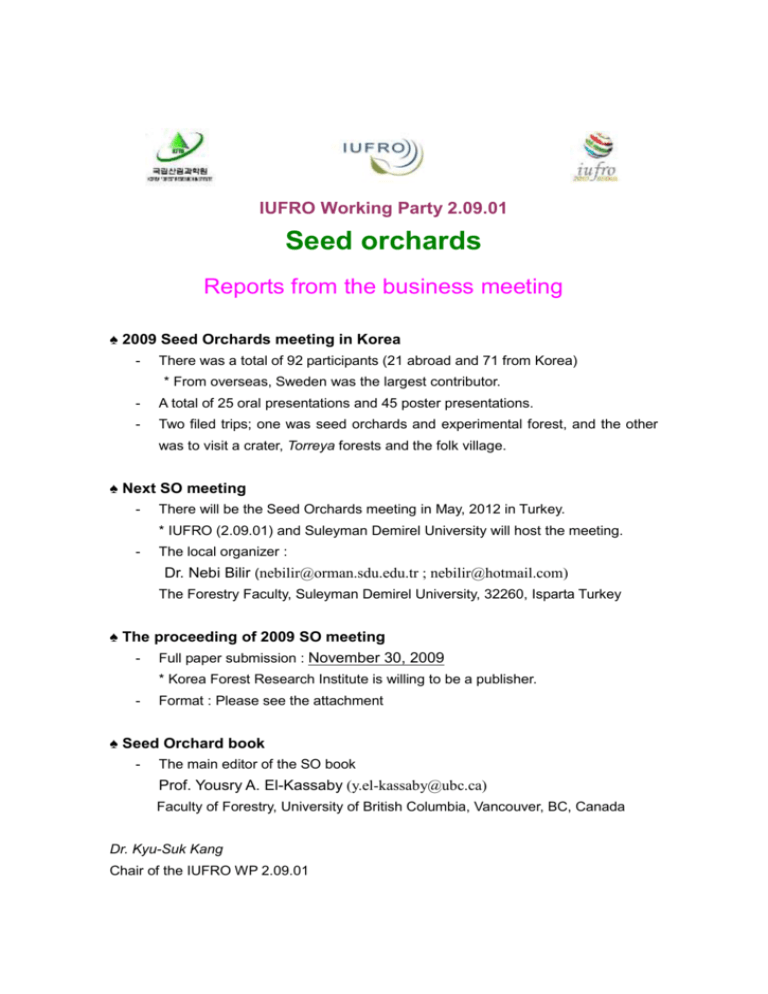A business meeting was hold
advertisement

IUFRO Working Party 2.09.01 Seed orchards Reports from the business meeting ♠ 2009 Seed Orchards meeting in Korea - There was a total of 92 participants (21 abroad and 71 from Korea) * From overseas, Sweden was the largest contributor. - A total of 25 oral presentations and 45 poster presentations. - Two filed trips; one was seed orchards and experimental forest, and the other was to visit a crater, Torreya forests and the folk village. ♠ Next SO meeting - There will be the Seed Orchards meeting in May, 2012 in Turkey. * IUFRO (2.09.01) and Suleyman Demirel University will host the meeting. - The local organizer : Dr. Nebi Bilir (nebilir@orman.sdu.edu.tr ; nebilir@hotmail.com) The Forestry Faculty, Suleyman Demirel University, 32260, Isparta Turkey ♠ The proceeding of 2009 SO meeting - Full paper submission : November 30, 2009 * Korea Forest Research Institute is willing to be a publisher. - Format : Please see the attachment ♠ Seed Orchard book - The main editor of the SO book Prof. Yousry A. El-Kassaby (y.el-kassaby@ubc.ca) Faculty of Forestry, University of British Columbia, Vancouver, BC, Canada Dr. Kyu-Suk Kang Chair of the IUFRO WP 2.09.01 Format of the proceeding paper Clonal fertility variation and its effects on the effective population size in a seed orchard of dioecious species, Fraxinus rhynchophylla By K.S. Kang1,*), C.S. Kim1), E.S. Baik1) and J.T. Kang2) 1 ) Department of Forest Resources Development, Korea Forest Research Institute, 44-3 Omokcheon, Suwon 441-847, Kyonggi, Republic of Korea 2 ) Forest Seed and Variety Center, Korea Forest Service, 670-4 Suheo, Chung-ju 380-941, Chungbuk, Republic of Korea *) Corresponding author : Kyu-Suk Kang (e-mail: kangks@forest.go.kr, tel; +82-31-290-1103, fax: +82-31-292-4458) Abstract The numbers of female and male flowers were assessed in a clonal seed orchard of Fraxinus rhynchophylla for four consecutive years from 2004 through 2007. The female and male flowers of the grafts were counted individually over the crown. Fertility variation was calculated by sibling coefficient that is related to the coefficient of variation in parental fertility. Estimated maternal and paternal fertilities based on the flower assessment were not constant but vary from year to year, and they were also found to be weakly correlated each other. Effective numbers of parents for mother and father were calculated from the sibling coefficients of maternal and paternal fertility variation. Clonal effective population sizes were estimated based on fertility variation (Ne(c)) and gender balance (Ne). The values of Ne(c) were higher in the years with good flower and seed production, while sibling coefficients were lower. On average (pooled), the values of Ne(c) were calculated to be 17.3, 21.0 and 38.1 for maternal, paternal and clonal fertility, respectively. The Ne(c) for maternal gamete pool was ranged from 9.8 to 16.7. The values of Ne for paternal gamete pool were generally higher (ranged from 14.9 to 21.9) than those for maternal. When pooled, the Ne was 47.3 and the values of Ne were higher when the gender ratio was more balanced. An option of equal seed harvest might be good to mitigate fertility variation and to improve gene diversity of seeds. Key words fertility variation, status number, sibling coefficient, gene diversity, equal seed harvest, Fraxinus rhynchophylla Introduction The maintenance and utilization of the high level of diversity for reforestation is a major criterion for breeding programs. As seed orchards become a predominant seed source, the breeding system of broad-leaves in an orchard merit increases scientific and managerial attention (Adams and Joly, 1983; Adams and Kunze, 1996). The aims of seed orchards are to produce sufficient amounts of seeds with high genetic quality and to achieve desirable genetic efficiency. The genetic efficiency of seed orchards depends primarily on the genetic value and genetic contribution of clones, the frequency of selfed embryos, and the proportion of embryos fertilized by external pollen (Matyas, 1991). The efficiency is also described as the degree to which the parental clones transfer their genetic superiority and diversity to their progenies. However, the orchard goals can be reached only if several prerequisites are met (Woessner and Franklin, 1973; Chaisurisri and El-Kassaby, 1993). One of these biological conditions is that the orchard parents have to contribute equally to their offspring for keeping diversity high. Unfortunately, in reality, they are not equally contributing (Jonsson et al., 1976; Muona and Harju, 1989; Kang and Lindgren, 1998), which will cause the reduction of effective population size and the increase of relatedness (Kjær, 1996; Kang and Lindgren, 1999). Effective population size (Ne) and status number (Ns) have been used for monitoring taking into account what are mainly considered as variations in fertility between orchard genotypes (Frankel and Soule, 1981; Kjær and Wellendorf, 1997; Lindgren and Mullin, 1998). Evaluating the effectiveness of female and male flower function in a wind-pollinated clonal seed orchard requires a standard measure on the relative probability of cross-pollination between all possible pairs of parents (Askew and Blush, 1990). Maternal and paternal reproductive success can be qualified by the proportion of flowers produced by each parent that is having high correlation with the number of fulfilled seeds (Kjær and Wellendorf, 1997). Field counts of female and male flowers can serve as rudimentary estimates of potential gamete contributions and hence fertility. The objectives of this study are to calculate effective number of parents and variance effective population sizes based on the fertility variation estimated by assessment of flower production among parents. Gene diversity of seeds and pollen contamination and their effects on the management of orchard populations are also discussed. Materials and Methods Seed orchard and flowering assessment The clonal seed orchard of Fraxinus rhynchophylla, operated by the Korea Forest Research Institute and located at Hwasung (lat. 36o30’N, long. 126o20’E, alt. 65m), was studied. This seed orchard was established with the intention of isolation from naturally occurring stands of this species. The seed orchard was established with grafts from plus trees in 1992. The design of the orchard was essentially random, and grafts were 2 years old at the time of establishment. The initial spacing was 5 x 5m spacing, and there has been no thinning and the survival of graft is 95 percent. The numbers of female and male flowers were counted for all grafts in the seed orchard in mid-May for four consecutive years from 2004 through 2007. The numbers of female and male flowers of the grafts were counted individually over the crown. A ladder was used to reach the upper part of the crown. The seed orchard consists of 48 clones with 2 ha in area, and the ramets per clone varied from 1 to 24. Rate of pollen contamination would not be fixed but varied year to year and there are a limited number of ash trees surrounding the seed orchard. So, we did not consider pollen contamination in this study. Fertility estimation The numbers of female and male gametes produced by an individual are maternal and paternal fertilities, respectively (GREGORIUS, 1989). Expected total fertility is an average of maternal and paternal fertility. Fertility variation can be described by sibling coefficient (Kang and Lindgren, 1999), the probability that two genes taken from gamete gene pool originate from the same parent, compared to a situation where all parents give raise to the same number of offspring. The sibling coefficient () is related to the coefficient of variation (CV) in parental fertility (Kang and Lindgren 1998; 1999). The sibling coefficient for the parental fertility can be divided into maternal sibling coefficient (m) and paternal sibling coefficient (p) as Nm m N m mi2 CVm2 1 and (1) i 1 Np p N p pi2 CVp2 1 i 1 (1-1) where CVm and CVp are the coefficients of variation in maternal and paternal fertility, Nm and Np are the numbers of mother and father parents, and mi and pi are the contributions of mother and father of the i-th clone, respectively. Total fertility variation () in an orchard is calculated in the case of that there is no pollen contamination from outside a seed orchard as (Kang and Lindgren 1999, Nikkanen and Ruotsalainen 2000), N Ψ N Fi m pi N i 2 i 1 p 0.5 N 2 i 1 0.25 m 2 (2) where Fi2 is the total fertility of i-th clone, and mi and pi are the contributions of maternity and paternity of the clone, respectively. N is the census number of parents in the seed orchard. Equal seed harvest is often proposed to control and mitigate the effect of unbalanced contribution among parents in stands and seed orchards (Kang and Lindgren, 1999; Bila, 2000). Equal seed harvest means that maternal fertility is kept constant (m = 1). Under equal seed harvest, the sibling coefficient depends only on the paternal fertility variation and pollen contamination as Ψ (1 2M ) 2 p 4M 3 4(1 M ) 2 (3) Effective population size by fertility variation Effective numbers of parents for mother [Ne(m)] and father [Ne(p)] were calculated from the sibling coefficients of maternal (m) and paternal (p) fertility variation, and clonal effective number (Ne) was estimated from the total fertility variation () as (Kang and Lindgren, 1999), N e( m) Nm m , N e( p ) Np p , N ec N Ψ (4) Here Nm and Np are the numbers of mother and father parents and N is the census number of parents in the seed orchard. Relative effective number of parents (Nr) is the inverse of the sibling coefficient (i.e., Nr = 1/). Effective population size by gender ratio The effective population size by gender ratio was estimated based on the number of female and male parents (Frankel and Soule, 1981) as, Ne 4N f Nm Nm N f (5) The results were then compared with the effective population size by fertility variation. Results Variation of flower production Table 1. Average flower production and coefficient of variation (CVm & CVp) between genders over 4-year assessment period in a clonal seed orchard of Fraxinus rhynchophylla 2004 Average CVm & CVp 2006 2007 Pooled ♀ ♂ ♀ ♂ ♀ ♂ ♀ ♂ ♀ ♂ 3,384 3,911 1,612 2,359 337 658 947 2,447 2,093 3,125 0.519 0.514 0.506 0.481 0.744 0.573 1.068 0.903 0.463 0.532 (CVm–CVp) a) a) 2005 0.005 0.025 0.171 0.164 -0.069 : difference of CV between maternal (CVm) and paternal (CVp) flower production Effective population size by fertility variation Table 2. Sibling coefficient (m & p), effective parent number [Ne(m) & Ne(p)] and relative effective parent number [Nr(m) & Nr(p)] for maternal and paternal gamete gene pool over four consecutive years. Maternal fertility 2004 2005 m & p * 1.270 1.256 2006 Paternal fertility 2007 1.554 2.140 Pooled 1.214 2004 2005 2006 2007 1.264 1.232 1.328 1.816 Pooled 1.283 Ne(m) & Ne(p) 16.5 16.7 13.5 9.8 17.3 21.4 21.9 20.3 14.9 21.0 Nr(m) & Nr(p) 0.79 0.80 0.64 0.47 0.82 0.79 0.81 0.75 0.55 0.78 * m and p represent maternal and paternal parents, respectively. Table 3. Sibling coefficient (), clonal effective population size [Ne(c)] and relative effective size (Nr) for gene pool over four successive years in the case where both fertilities vary and maternal fertility was kept constant. Gene migration was set to be 0.15. Maternal and paternal fertility Maternal fertility constant (equal seed vary harvest) 2004 2005 2006 2007 Pooled 1.282 1.260 1.468 Ne(c) 37.5 38.1 32.7 23.9 38.1 Nr 0.78 0.79 0.68 0.50 0.79 2004 2005 2006 2007 Pooled 2.006 1.259 Fig. 1. Temporal change of relative effective number of parents (Nr) based on the female, male and clonal fertility variation under assumption of no pollen contamination in the seed orchard of F. rhynchophylla . Fig. 2. Relative effective number of parents (Nr) at the different levels of gene migration (M) and paternal fertility (CVp) in an equal seed harvest. In the equal seed harvest from each clone, the fertility variation of maternal parents is kept to be zero (CVm = 0; m = 0) and thus there is no correlation between genders (r = 0). Effective population size by gender ratios Table 4. Numbers of mother (Nm) and father parents (Np) and effective population size (Ne) by sex ratio in a seed orchard of dioecious species, F. rhynchophylla 2004 Nm & Np Ne 2005 2006 2007 Pooled ♀ ♂ ♀ ♂ ♀ ♂ ♀ ♂ ♀ ♂ 21 27 21 26 20 25 19 26 21 27 47.3 46.5 44.4 43.9 47.3 The values of Ne were higher than those of Ne(c). When pooled, the Ne was estimated to be 47.3. In other words, the amount of random genetic drift in the seed orchard of 48 clones is equal to that in an ideal population made up of mating randomly between 23.6 maternal and 23.6 paternal (balanced sex ratio). But, this estimation should have the assumption that the maternal and paternal parents have the same contribution to subsequent generation (Frankel and Soule, 1981). Discussion Fertility variation Theory on fertility variation among seed orchard parents was formulated considering maternal and paternal fertility variation, correlation between maternal and paternal fertilities, and gene migration from outside. Fertility variation could be described by sibling coefficient, describing how much fertility varies among parents as the increase in the probability that sibs occur compared to the situation where fertility is equal across the population. Derived formulas were used to estimate parental fertility variation and applied for calculating effective parent numbers and variance effective population sizes into a monoecious species population. An equal amount of seed harvest from each parent (i.e., keeping maternal fertility equally) was also compared to the seed collection where maternal and paternal fertilities varied. Make it short and move to the end of Abstract or Introduction. Effective population sizes It was assumed that contaminating pollen was not related with orchard pollen and affecting equally to the paternal parents. Under assumption of no pollen contamination, this equation confirms that the sibling coefficient, T = 0.25(m + p) + 0.5. Thus, the effective number of parents equals to be the census number if there is equal fertility; that is to say, with no selection the population is “ideal” and the progeny are distributed in Poisson fashion (Kimura and Crow 1963). The Np depends only on the fertility variation among clones and does not depend on how parents are related or inbred (e.g., selfing is regarded as producing two offspring). It often seems to be identical to the classical “inbreeding effective number” (e.g., Robertson 1961; Kimura and Crow 1963). Acknowledgements This study was supported by the Korea Forest Research Institute and authors thank to …. Literature cited Askew GR (1985) Quantifying uniformity of gamete production in seed orchards. Silvae Genet. 34: 186-188. Admas GW, Joly RJ (1980) Allozyme studies in loblolly pine seed orchards: clonal variation and frequency of progeny due to self-fertilization. Silvae Genet. 29: 1-4. Admas GW, Kunze HA (1996) Clonal variation in cone and seed production in black and white spruce seed orchards and management implications. For. Chron. 72: 475-480. Caron GE, Powell GD (1989) Patterns of seed-cone and pollen-cone production in young Picea mariana trees. Can. J. For. Res. 19: 359-364. Chaisurisri K, El-Kassaby YA (1993) Estimation of clonal contribution to cone and seed crops in a Sitka spruce seed orchard. Ann. Sci. For. 50: 461-467. Cheliak WM, Skroppa T, Pitel JA (1987) Genetics of polycross 1. Experimental results from Norway spruce. Theor. Appl. Genet. 73: 321-329. El-Kassaby YA, Reynolds S (1990) Reproductive phenology, parental balance, and supplemental mass pollination in a Sitka spruce seed orchard. For. Ecol. Manage. 31: 45-54. El-Kassaby YA, Fashler AMK, Crown M (1989) Variation in fruitfulness in a Douglas-fir seed orchard and its effect on crop-management decisions. Silvae Genet. 38: 113-121. Eriksson G, Jonsson A, Lindgren D (1973) Flowering in a clone trail of Picea abies L. Stud. For. Suec. 110: 45pp. Falconer D.S, Mackay TFC (1996) Introduction to quantitative genetics. 4th ed. Longman, Malaysia. Frankel, O.H. and Soule, M.E. 1981. Conservation and evolution. Cambridge University Press. p.31-77. Fries A (1994) Development of flowering and the effect of pruning in a clonal seed orchard of lodgepole pine. Can. J. For. Res. 24: 71-76. Griffin AR (1982) Clonal variation in Radiata pine seed orchard. I. Some flowering, cone, and seed production traits. Aust. For. Res. 12: 295-302. Jonsson A, Ekberg J, Eriksson G (1976) Flowering in a seed orchard of Pinus sylvestris L. Stud. For. Suec. 135: 38pp. Kang KS, Harju AM, Lindgren D, Nikkanen T, Almqvist C, Suh GU (2001b) Variation in effective number of clones in seed orchards. New For. 21: 17-33. Kjær ED, Wellendorf H (1997) Variation in flowering and reproductive success in a Danish Picea abies (Karst.) seed orchard. For. Genet. 4: 181-188.








